Zhaoye Fei
World Modeling Makes a Better Planner: Dual Preference Optimization for Embodied Task Planning
Mar 13, 2025Abstract:Recent advances in large vision-language models (LVLMs) have shown promise for embodied task planning, yet they struggle with fundamental challenges like dependency constraints and efficiency. Existing approaches either solely optimize action selection or leverage world models during inference, overlooking the benefits of learning to model the world as a way to enhance planning capabilities. We propose Dual Preference Optimization (D$^2$PO), a new learning framework that jointly optimizes state prediction and action selection through preference learning, enabling LVLMs to understand environment dynamics for better planning. To automatically collect trajectories and stepwise preference data without human annotation, we introduce a tree search mechanism for extensive exploration via trial-and-error. Extensive experiments on VoTa-Bench demonstrate that our D$^2$PO-based method significantly outperforms existing methods and GPT-4o when applied to Qwen2-VL (7B), LLaVA-1.6 (7B), and LLaMA-3.2 (11B), achieving superior task success rates with more efficient execution paths.
How to Mitigate Overfitting in Weak-to-strong Generalization?
Mar 06, 2025Abstract:Aligning powerful AI models on tasks that surpass human evaluation capabilities is the central problem of \textbf{superalignment}. To address this problem, weak-to-strong generalization aims to elicit the capabilities of strong models through weak supervisors and ensure that the behavior of strong models aligns with the intentions of weak supervisors without unsafe behaviors such as deception. Although weak-to-strong generalization exhibiting certain generalization capabilities, strong models exhibit significant overfitting in weak-to-strong generalization: Due to the strong fit ability of strong models, erroneous labels from weak supervisors may lead to overfitting in strong models. In addition, simply filtering out incorrect labels may lead to a degeneration in question quality, resulting in a weak generalization ability of strong models on hard questions. To mitigate overfitting in weak-to-strong generalization, we propose a two-stage framework that simultaneously improves the quality of supervision signals and the quality of input questions. Experimental results in three series of large language models and two mathematical benchmarks demonstrate that our framework significantly improves PGR compared to naive weak-to-strong generalization, even achieving up to 100\% PGR on some models.
VLABench: A Large-Scale Benchmark for Language-Conditioned Robotics Manipulation with Long-Horizon Reasoning Tasks
Dec 24, 2024Abstract:General-purposed embodied agents are designed to understand the users' natural instructions or intentions and act precisely to complete universal tasks. Recently, methods based on foundation models especially Vision-Language-Action models (VLAs) have shown a substantial potential to solve language-conditioned manipulation (LCM) tasks well. However, existing benchmarks do not adequately meet the needs of VLAs and relative algorithms. To better define such general-purpose tasks in the context of LLMs and advance the research in VLAs, we present VLABench, an open-source benchmark for evaluating universal LCM task learning. VLABench provides 100 carefully designed categories of tasks, with strong randomization in each category of task and a total of 2000+ objects. VLABench stands out from previous benchmarks in four key aspects: 1) tasks requiring world knowledge and common sense transfer, 2) natural language instructions with implicit human intentions rather than templates, 3) long-horizon tasks demanding multi-step reasoning, and 4) evaluation of both action policies and language model capabilities. The benchmark assesses multiple competencies including understanding of mesh\&texture, spatial relationship, semantic instruction, physical laws, knowledge transfer and reasoning, etc. To support the downstream finetuning, we provide high-quality training data collected via an automated framework incorporating heuristic skills and prior information. The experimental results indicate that both the current state-of-the-art pretrained VLAs and the workflow based on VLMs face challenges in our tasks.
InternLM2 Technical Report
Mar 26, 2024
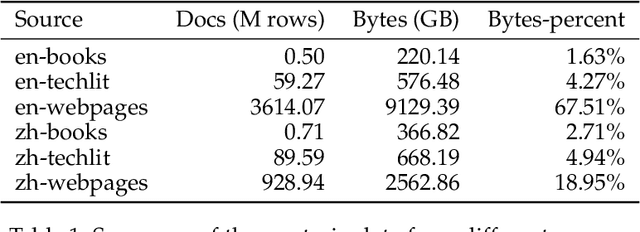
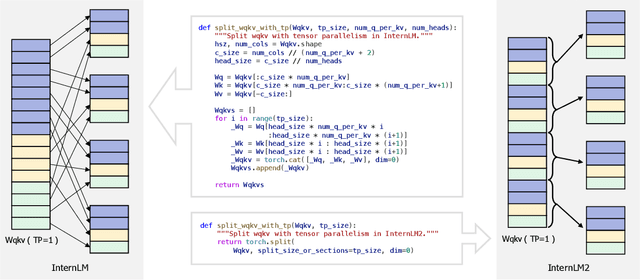

Abstract:The evolution of Large Language Models (LLMs) like ChatGPT and GPT-4 has sparked discussions on the advent of Artificial General Intelligence (AGI). However, replicating such advancements in open-source models has been challenging. This paper introduces InternLM2, an open-source LLM that outperforms its predecessors in comprehensive evaluations across 6 dimensions and 30 benchmarks, long-context modeling, and open-ended subjective evaluations through innovative pre-training and optimization techniques. The pre-training process of InternLM2 is meticulously detailed, highlighting the preparation of diverse data types including text, code, and long-context data. InternLM2 efficiently captures long-term dependencies, initially trained on 4k tokens before advancing to 32k tokens in pre-training and fine-tuning stages, exhibiting remarkable performance on the 200k ``Needle-in-a-Haystack" test. InternLM2 is further aligned using Supervised Fine-Tuning (SFT) and a novel Conditional Online Reinforcement Learning from Human Feedback (COOL RLHF) strategy that addresses conflicting human preferences and reward hacking. By releasing InternLM2 models in different training stages and model sizes, we provide the community with insights into the model's evolution.
WanJuan-CC: A Safe and High-Quality Open-sourced English Webtext Dataset
Mar 12, 2024
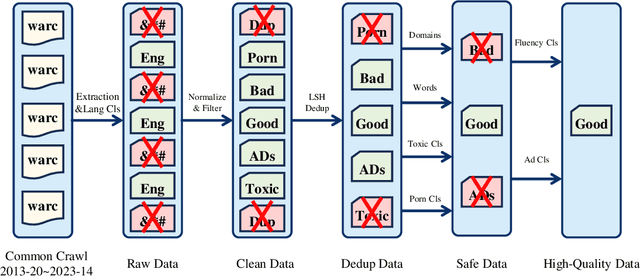
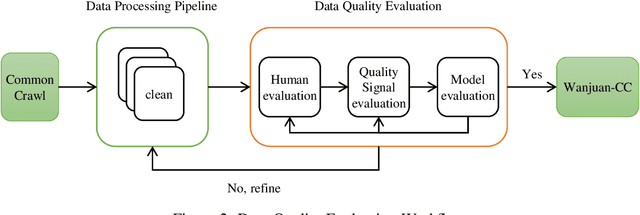

Abstract:This paper presents WanJuan-CC, a safe and high-quality open-sourced English webtext dataset derived from Common Crawl data. The study addresses the challenges of constructing large-scale pre-training datasets for language models, which require vast amounts of high-quality data. A comprehensive process was designed to handle Common Crawl data, including extraction, heuristic rule filtering, fuzzy deduplication, content safety filtering, and data quality filtering. From approximately 68 billion original English documents, we obtained 2.22T Tokens of safe data and selected 1.0T Tokens of high-quality data as part of WanJuan-CC. We have open-sourced 100B Tokens from this dataset. The paper also provides statistical information related to data quality, enabling users to select appropriate data according to their needs. To evaluate the quality and utility of the dataset, we trained 1B-parameter and 3B-parameter models using WanJuan-CC and another dataset, RefinedWeb. Results show that WanJuan-CC performs better on validation datasets and downstream tasks.
Balanced Data Sampling for Language Model Training with Clustering
Feb 22, 2024Abstract:Data plays a fundamental role in the training of Large Language Models (LLMs). While attention has been paid to the collection and composition of datasets, determining the data sampling strategy in training remains an open question. Most LLMs are trained with a simple strategy, random sampling. However, this sampling strategy ignores the unbalanced nature of training data distribution, which can be sub-optimal. In this paper, we propose ClusterClip Sampling to balance the text distribution of training data for better model training. Specifically, ClusterClip Sampling utilizes data clustering to reflect the data distribution of the training set and balances the common samples and rare samples during training based on the cluster results. A repetition clip operation is introduced to mitigate the overfitting issue led by samples from certain clusters. Extensive experiments validate the effectiveness of ClusterClip Sampling, which outperforms random sampling and other cluster-based sampling variants under various training datasets and large language models.
Turn Waste into Worth: Rectifying Top-$k$ Router of MoE
Feb 21, 2024



Abstract:Sparse Mixture of Experts (MoE) models are popular for training large language models due to their computational efficiency. However, the commonly used top-$k$ routing mechanism suffers from redundancy computation and memory costs due to the unbalanced routing. Some experts are overflow, where the exceeding tokens are dropped. While some experts are vacant, which are padded with zeros, negatively impacting model performance. To address the dropped tokens and padding, we propose the Rectify-Router, comprising the Intra-GPU Rectification and the Fill-in Rectification. The Intra-GPU Rectification handles dropped tokens, efficiently routing them to experts within the GPU where they are located to avoid inter-GPU communication. The Fill-in Rectification addresses padding by replacing padding tokens with the tokens that have high routing scores. Our experimental results demonstrate that the Intra-GPU Rectification and the Fill-in Rectification effectively handle dropped tokens and padding, respectively. Furthermore, the combination of them achieves superior performance, surpassing the accuracy of the vanilla top-1 router by 4.7%.
InternLM-Math: Open Math Large Language Models Toward Verifiable Reasoning
Feb 09, 2024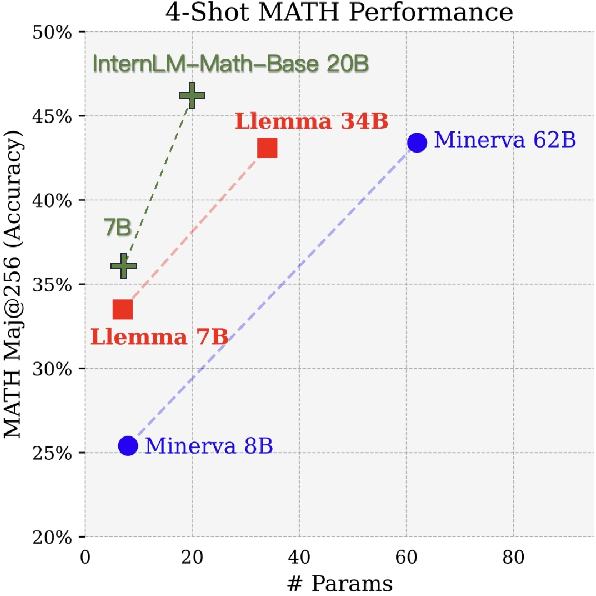

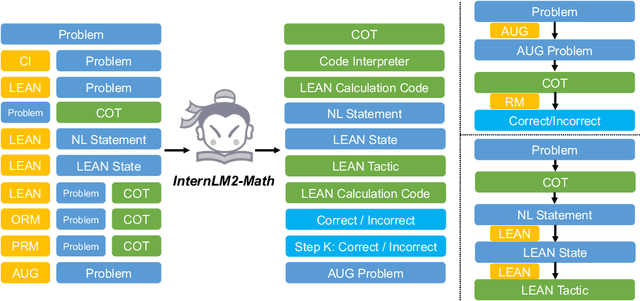
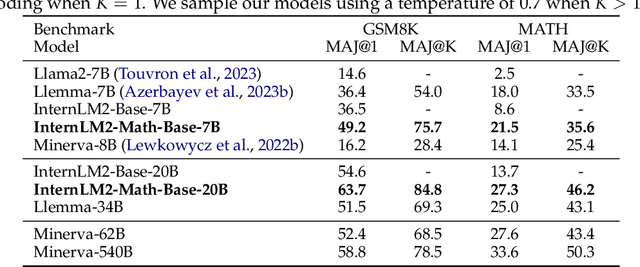
Abstract:The math abilities of large language models can represent their abstract reasoning ability. In this paper, we introduce and open-source our math reasoning LLMs InternLM-Math which is continue pre-trained from InternLM2. We unify chain-of-thought reasoning, reward modeling, formal reasoning, data augmentation, and code interpreter in a unified seq2seq format and supervise our model to be a versatile math reasoner, verifier, prover, and augmenter. These abilities can be used to develop the next math LLMs or self-iteration. InternLM-Math obtains open-sourced state-of-the-art performance under the setting of in-context learning, supervised fine-tuning, and code-assisted reasoning in various informal and formal benchmarks including GSM8K, MATH, Hungary math exam, MathBench-ZH, and MiniF2F. Our pre-trained model achieves 30.3 on the MiniF2F test set without fine-tuning. We further explore how to use LEAN to solve math problems and study its performance under the setting of multi-task learning which shows the possibility of using LEAN as a unified platform for solving and proving in math. Our models, codes, and data are released at \url{https://github.com/InternLM/InternLM-Math}.
Query of CC: Unearthing Large Scale Domain-Specific Knowledge from Public Corpora
Jan 26, 2024Abstract:Large language models have demonstrated remarkable potential in various tasks, however, there remains a significant scarcity of open-source models and data for specific domains. Previous works have primarily focused on manually specifying resources and collecting high-quality data on specific domains, which significantly consume time and effort. To address this limitation, we propose an efficient data collection method~\textit{Query of CC} based on large language models. This method bootstraps seed information through a large language model and retrieves related data from public corpora. It not only collects knowledge-related data for specific domains but unearths the data with potential reasoning procedures. Through the application of this method, we have curated a high-quality dataset called~\textsc{Knowledge Pile}, encompassing four major domains, including stem and humanities sciences, among others. Experimental results demonstrate that~\textsc{Knowledge Pile} significantly improves the performance of large language models in mathematical and knowledge-related reasoning ability tests. To facilitate academic sharing, we open-source our dataset and code, providing valuable support to the academic community.
Pre-training for Information Retrieval: Are Hyperlinks Fully Explored?
Sep 14, 2022

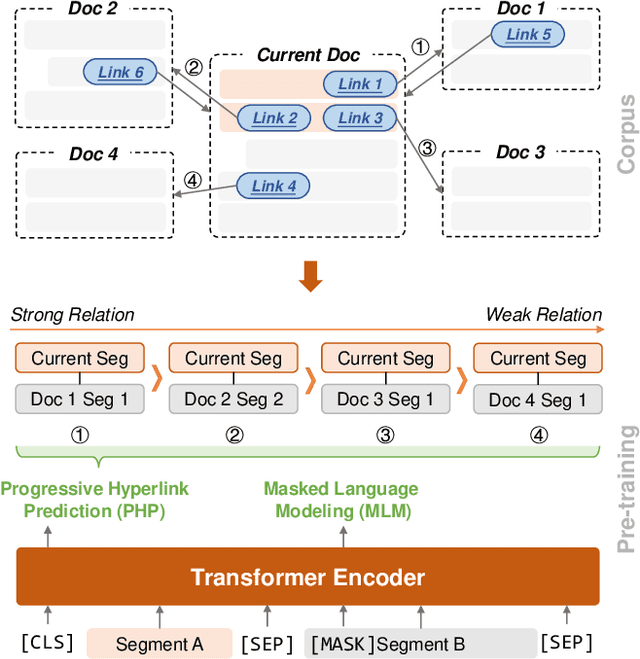

Abstract:Recent years have witnessed great progress on applying pre-trained language models, e.g., BERT, to information retrieval (IR) tasks. Hyperlinks, which are commonly used in Web pages, have been leveraged for designing pre-training objectives. For example, anchor texts of the hyperlinks have been used for simulating queries, thus constructing tremendous query-document pairs for pre-training. However, as a bridge across two web pages, the potential of hyperlinks has not been fully explored. In this work, we focus on modeling the relationship between two documents that are connected by hyperlinks and designing a new pre-training objective for ad-hoc retrieval. Specifically, we categorize the relationships between documents into four groups: no link, unidirectional link, symmetric link, and the most relevant symmetric link. By comparing two documents sampled from adjacent groups, the model can gradually improve its capability of capturing matching signals. We propose a progressive hyperlink predication ({PHP}) framework to explore the utilization of hyperlinks in pre-training. Experimental results on two large-scale ad-hoc retrieval datasets and six question-answering datasets demonstrate its superiority over existing pre-training methods.
 Add to Chrome
Add to Chrome Add to Firefox
Add to Firefox Add to Edge
Add to Edge